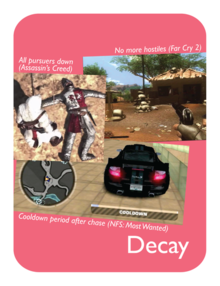Difference between revisions of "Decay"
ValterAlves (Talk | contribs) m |
ValterAlves (Talk | contribs) m |
||
| Line 18: | Line 18: | ||
[[Decay]] is a transient phase in the game's [[Emotional Script]]. Its opportunity is dictated by the [[Gameplay]] and it has a short duration. It aims at leading or supporting the player while changing from a state of high arousal (e.g. the end of an [[Engagement]]) to a state of low arousal (as [[Relaxation]]). Usually these several phases relate in a iterated sequence ([[R-A-E-D Iterations]]). | [[Decay]] is a transient phase in the game's [[Emotional Script]]. Its opportunity is dictated by the [[Gameplay]] and it has a short duration. It aims at leading or supporting the player while changing from a state of high arousal (e.g. the end of an [[Engagement]]) to a state of low arousal (as [[Relaxation]]). Usually these several phases relate in a iterated sequence ([[R-A-E-D Iterations]]). | ||
| − | + | A common approach is to perform a fade out in the ([[Engagement]]) [[Music]]. Other approaches using [[Entrainment]] (including [[Music]], too), are also interesting. Some designers also opted to explicitly informing the player about the change in arousal states through diegetic [[Dialogue]]. | |
| examples= | | examples= | ||
Revision as of 18:12, 15 October 2011

|

| |
| The card's front face | The card's back face |
Contents
Synopsis
| A phase of gameplay of reestablishment after an engagement. |
Relationships
Context:
R-A-E-D Iterations ![]() , Gameplay File:M385px-Gameplay-front-v20.png, Emotional Script
, Gameplay File:M385px-Gameplay-front-v20.png, Emotional Script ![]() .
.
Peers:
Relaxation ![]() , Anticipation
, Anticipation ![]() , Engagement
, Engagement ![]() .
.
May use:
Music ![]() , Dialogue
, Dialogue ![]() , Entrainment
, Entrainment ![]() .
.
Description
Decay is a transient phase in the game's Emotional Script. Its opportunity is dictated by the Gameplay and it has a short duration. It aims at leading or supporting the player while changing from a state of high arousal (e.g. the end of an Engagement) to a state of low arousal (as Relaxation). Usually these several phases relate in a iterated sequence (R-A-E-D Iterations).
A common approach is to perform a fade out in the (Engagement) Music. Other approaches using Entrainment (including Music, too), are also interesting. Some designers also opted to explicitly informing the player about the change in arousal states through diegetic Dialogue.
Examples





